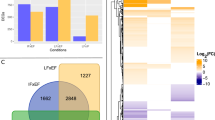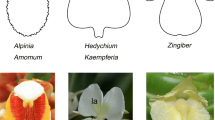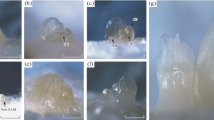Abstract
Main conclusion
Characterization of anther and ovule developmental programs and expression analyses of stage-specific floral marker genes in Gossypium hirsutum allowed to build a comprehensive portrait of cotton flower development before fiber initiation.
Abstract
Gossypium hirsutum is the most important cotton species that is cultivated worldwide. Although cotton reproductive development is important for fiber production, since fiber is formed on the epidermis of mature ovules, cotton floral development remains poorly understood. Therefore, this work aims to characterize the cotton floral morphoanatomy by performing a detailed description of anther and ovule developmental programs and identifying stage-specific floral marker genes in G. hirsutum. Using light microscopy and scanning electron microscopy, we analyzed anther and ovule development during 11 stages of flower development. To better characterize the ovule development in cotton, we performed histochemical analyses to evaluate the accumulation of phenolic compounds, pectin, and sugar in ovule tissues. After identification of major hallmarks of floral development, three key stages were established in G. hirsutum floral development: in stage 1 (early—EF), sepal, petal, and stamen primordia were observed; in stage 2 (intermediate—IF), primordial ovules and anthers are present, and the differentiating archesporial cells were observed, marking the beginning of microsporogenesis; and in stage 6 (late—LF), flower buds presented initial anther tapetum degeneration and microspore were released from the tetrad, and nucellus and both inner and outer integuments are developing. We used transcriptome data of cotton EF, IF and LF stages to identify floral marker genes and evaluated their expression by real-time quantitative PCR (qPCR). Twelve marker genes were preferentially expressed in a stage-specific manner, including the putative homologs for AtLEAFY, AtAPETALA 3, AtAGAMOUS-LIKE 19 and AtMALE STERILITY 1, which are crucial for several aspects of reproductive development, such as flower organogenesis and anther and petal development. We also evaluated the expression profile of B-class MADS-box genes in G. hirsutum floral transcriptome (EF, IF, and LF). In addition, we performed a comparative analysis of developmental programs between Arabidopsis thaliana and G. hirsutum that considered major morphoanatomical and molecular processes of flower, anther, and ovule development. Our findings provide the first detailed analysis of cotton flower development.







Similar content being viewed by others
Abbreviations
- qPCR:
-
Real-time quantitative PCR
- EF:
-
Early flower bud stage
- IF:
-
Intermediate flower bud stage
- LF:
-
Late flower bud stage
- FB:
-
Flower bud
- SEM:
-
Scanning electron microscopy
References
Alvarez-Buylla ER, Benítez M, Corvera-Poiré A et al (2010) Flower development. Arabidopsis Book 8:e0127. https://doi.org/10.1199/tab.0127
Alves-Ferreira M, Wellmer F, Banhara A et al (2007) Global expression profiling applied to the analysis of Arabidopsis stamen development. Plant Physiol 145:747–762. https://doi.org/10.1104/pp.107.104422
Artico S, Nardeli SM, Brilhante O et al (2010) Identification and evaluation of new reference genes in Gossypium hirsutum for accurate normalization of real-time quantitative RT-PCR data. BMC Plant Biol 10:1–12. https://doi.org/10.1186/1471-2229-10-49
Ashraf J, Zuo D, Wang Q et al (2018) Recent insights into cotton functional genomics: progress and future perspectives. Plant Biotechnol J 16:699–713. https://doi.org/10.1111/pbi.12856
Bowman JL, Alvarez J, Weigel D et al (1993) Control of flower development in Arabidopsis thaliana by APETALA1 and interacting genes. Development 119:721–743. https://doi.org/10.1016/j.anbehav.2009.06.003
Carroll A, Mansoori N, Li S et al (2012) Complexes with mixed primary and secondary cellulose synthases are functional in Arabidopsis plants. Plant Physiol 160:726–737. https://doi.org/10.1104/pp.112.199208
Cheng F, Wu J, Cai X et al (2018) Gene retention, fractionation and subgenome differences in polyploid plants. Nat Plants 4:258–268. https://doi.org/10.1038/s41477-018-0136-7
de Moura SM, Artico S, Lima C et al (2017) Functional characterization of AGAMOUS-subfamily members from cotton during reproductive development and in response to plant hormones. Plant Reprod. https://doi.org/10.1007/s00497-017-0297-y
Dean G, Cao Y, Xiang D et al (2011) Analysis of gene expression patterns during seed coat development in Arabidopsis. Mol Plant 4:1074–1091. https://doi.org/10.1093/mp/ssr040
Dobritsa AA, Lei Z, Nishikawa S-I et al (2010) LAP5 and LAP6 encode anther-specific proteins with similarity to chalcone synthase essential for pollen exine development in Arabidopsis. Plant Physiol 153:937–955. https://doi.org/10.1104/pp.110.157446
Du Z, Zhou X, Ling Y et al (2010) agriGO: a GO analysis toolkit for the agricultural community. Nucleic Acids Res 38:64–70. https://doi.org/10.1093/nar/gkq310
Dubois A, Remay A, Raymond O et al (2011) Genomic approach to study floral development genes in Rosa sp. PLoS ONE. https://doi.org/10.1371/journal.pone.0028455
Endress PK (2011) Angiosperm ovules: diversity, development, evolution. Ann Bot 107:1465–1489. https://doi.org/10.1093/aob/mcr120
Erickson AN, Markhart AH (2002) Flower developmental stage and organ sensitivity of bell pepper (Capsicum annuum L.) to elevated temperature. Plant Cell Environ 25(1):123–130. https://doi.org/10.1046/j.0016-8025.2001.00807.x
Favaro R, Pinyopich A (2003) MADS-box protein complexes control carpel and ovule development in Arabidopsis. Plant Cell 15:2603–2611. https://doi.org/10.1105/tpc.015123.2
Flagel LE, Chen L, Chaudhary B, Wendel JF (2009) Coordinated and fine-scale control of homoeologous gene expression in allotetraploid cotton. J Hered 100:487–490. https://doi.org/10.1093/jhered/esp003
Francoz E, Ranocha P, Nguyen-Kim H et al (2015) Roles of cell wall peroxidases in plant development. Phytochemistry 112:15–21. https://doi.org/10.1016/j.phytochem.2014.07.020
Furutani I, Sukegawa S, Kyozuka J (2006) Genome-wide analysis of spatial and temporal gene expression in rice panicle development. Plant J 46:503–511. https://doi.org/10.1111/j.1365-313X.2006.02703.x
Goldberg RB, Beals TP, Sanders PM (1993) Anther development: basic principles and practical applications. Plant Cell 5:1217–1229. https://doi.org/10.1105/tpc.5.10.1217
Goto K, Pi T, Words K et al (1994) Function and regulation of the Arabidopsis floral homeotic gene PISTILLATA. Genes Dev. 8(13):1548–1560. https://doi.org/10.1101/gad.8.13.1548
Griffiths JS, Šola K, Kushwaha R et al (2015) Unidirectional movement of cellulose synthase complexes in Arabidopsis seed coat epidermal cells deposit cellulose involved in mucilage extrusion, adherence, and ray formation. Plant Physiol 168(2):502–520. https://doi.org/10.1104/pp.15.00478
Guan X, Lee JJ, Pang M et al (2011) Activation of Arabidopsis seed hair development by cotton fiber-related genes. PLoS ONE 6(7):e21301. https://doi.org/10.1371/journal.pone.0021301
Guo Y, Zhu Q, Zheng S, Li M (2007) Cloning of a MADS box gene (GhMADS3) from cotton and analysis of its homeotic role in transgenic tobacco. J Genet Genomics 34:527–535. https://doi.org/10.1016/S1673-8527(07)60058-7
Hellemans J, Mortier G, De Paepe A et al (2007) qBase relative quantification framework and software for management and automated analysis of real-time quantitative PCR data. Genomebiology 8:R19. https://doi.org/10.1186/gb-2007-8-2-r19
Huang M-D, Wei F-J, Wu C-C et al (2008) Analyses of advanced rice anther transcriptomes reveal global tapetum secretory functions and potential proteins for lipid exine formation. Plant Physiol 149:694–707. https://doi.org/10.1104/pp.108.131128
Irshad M, Canut H, Borderies G et al (2008) A new picture of cell wall protein dynamics in elongating cells of Arabidopsis thaliana: confirmed actors and newcomers. BMC Plant Biol 8:94. https://doi.org/10.1186/1471-2229-8-94
Ischebeck T, Valledor L, Lyon D et al (2014) Comprehensive cell-specific protein analysis in early and late pollen development from diploid microsporocytes to pollen tube growth. Mol Cell Proteomics 13:295–310. https://doi.org/10.1074/mcp.M113.028100
Ito T, Shinozaki K (2002) The MALE STERILITY1 gene of Arabidopsis, encoding a nuclear protein with a PHD-finger motif, is expressed in tapetal cells and is required for pollen maturation. Plant Cell Physiol 43:1285–1292. https://doi.org/10.1093/pcp/pcf154
Ito T, Nagata N, Yoshiba Y et al (2007) Arabidopsis MALE STERILITY1 encodes a PHD-type transcription factor and regulates pollen and tapetum development. Plant Cell 19:3549–3562. https://doi.org/10.1105/tpc.107.054536
Jack T, Brockman LL, Meyerowitz EM (1992) The homeotic gene APETALA3 of Arabidopsis thaliana encodes a MADS box and is expressed in petals and stamens. Cell 68:683–697. https://doi.org/10.1016/0092-8674(92)90144-2
Jiang S, Pang C, Song M et al (2014) Analysis of MIKCC-type MADS-box gene family in Gossypium hirsutum. J Integr Agric 13:1239–1249. https://doi.org/10.1016/S2095-3119(13)60520-1
Jiménez-López D, Bravo J, Guzmán P (2015) Evolutionary history exposes radical diversification among classes of interaction partners of the MLLE domain of plant poly(A)-binding proteins. BMC Evol Biol 15:195. https://doi.org/10.1186/s12862-015-0475-1
Johansen DA (1940) Plant microtechnique. McGraw-Hill Book Co., New York
Kang MJ, Jin HS, Noh YS, Noh B (2015) Repression of flowering under a noninductive photoperiod by the HDA9-AGL19-FT module in Arabidopsis. New Phytol 206:281–294. https://doi.org/10.1111/nph.13161
Kelley DR, Gasser ÆCS (2009) Ovule development: genetic trends and evolutionary considerations. Sex Plant Reprod. https://doi.org/10.1007/s00497-009-0107-2
Kou X, Watkins CB, Gan S-S (2012) Arabidopsis AtNAP regulates fruit senescence. J Exp Bot 63:6139–6147. https://doi.org/10.1093/jxb/ers266
Kouchi J (1988) Ontogenetic development of spinous exine in Hibiscus syriacus (Malvaceae). Am J Bot 75:1549–1558. https://doi.org/10.2307/2444705
Kramer EM, Dorit RL, Irish VF (1998) Molecular evolution of genes controlling petal and stamen development: duplication and divergence within the APETALA3 and PISTILLATA MADS-box gene lineages. Genetics 149:765–783
Kwon YR, Lee HJ, Kim KH et al (2008) Ectopic expression of Expansin3 or Expansinβ1 causes enhanced hormone and salt stress sensitivity in Arabidopsis. Biotechnol Lett 30:1281–1288. https://doi.org/10.1007/s10529-008-9678-5
Lamb RS, Hill TA, Tan QK-G, Irish VF (2002) Regulation of APETALA3 floral homeotic gene expression by meristem identity genes. Development 129:2079–2086
Langmead B, Trapnell C, Pop M, Salzberg S (2009) 2C- Ultrafast and memory-efficient alignment of short DNA sequences to the human genome. Genome Biol 10:R25. https://doi.org/10.1186/gb-2009-10-3-r25
Lau S, Schwarzacher T, Othman RY, Harikrishna JA (2015) dsRNA silencing of an R2R3-MYB transcription factor affects flower cell shape in a Dendrobium hybrid. BMC Plant Biol. https://doi.org/10.1186/s12870-015-0577-3
Lee JJ, Woodward AW, Chen ZJ (2007) Gene expression changes and early events in cotton fibre development. Ann Bot 100:1391–1401. https://doi.org/10.1093/aob/mcm232
Li J, Fan SL, Song MZ et al (2013a) Cloning and characterization of a FLO/LFY ortholog in Gossypium hirsutum L. Plant Cell Rep 32:1675–1686. https://doi.org/10.1007/s00299-013-1479-1
Li X, Liu C, Da F et al (2013b) Expression pattern of class B gene PAP3 in flower development of pepper. Int J Mol Sci 14:24643–24655. https://doi.org/10.3390/ijms141224643
Li F, Fan G, Lu C et al (2015) Genome sequence of cultivated Upland cotton (Gossypium hirsutum TM-1) provides insights into genome evolution. Nat Biotechnol 33:524–531. https://doi.org/10.1038/nbt.3208
Lightfoot DJ, Malone KM, Timmis JN, Orford SJ (2008) Evidence for alternative splicing of MADS-box transcripts in developing cotton fibre cells. Mol Genet Genomics 279:75–85. https://doi.org/10.1007/s00438-007-0297-y
Liljegren SJ, Gustafson-Brown C, Pinyopich A et al (1999) Interactions among APETALA1, LEAFY, and TERMINAL FLOWER1 specify meristem fate. Plant Cell 11:1007–1018. https://doi.org/10.1105/tpc.11.6.1007
Liljegren SJ, Ditta GS, Eshed Y et al (2000) SHATTERPROOF MADS-box genes control seed dispersal in Arabidopsis. Nature 404:766–770
Liu X, Zuo KJ, Xu JT et al (2010) Functional analysis of GbAGL1, a D-lineage gene from cotton (Gossypium barbadense). J Exp Bot 61:1193–1203. https://doi.org/10.1093/jxb/erp388
Liu H, Sun M, Du D et al (2015) Whole-transcriptome analysis of differentially expressed genes in the vegetative buds, floral buds and buds of Chrysanthemum morifolium. PLoS ONE 10:1–24. https://doi.org/10.1371/journal.pone.0128009
Lozano R, Angosto T, Go P et al (1998) Tomato flower abnormalities induced by low temperatures MADS-box genes. Plant Physiol 1:91–100. https://doi.org/10.1104/pp.117.1.91
Mansoor S, Paterson AH (2012) Genomes for jeans: cotton genomics for engineering superior fiber. Trends Biotechnol 30:521–527. https://doi.org/10.1016/j.tibtech.2012.06.003
Nardeli SM, Artico S, Aoyagi GM et al (2018) Genome-wide analysis of the MADS-box gene family in polyploid cotton (Gossypium hirsutum) and in its diploid parental species (Gossypium arboreum and Gossypium raimondii). Plant Physiol Biochem. https://doi.org/10.1016/j.plaphy.2018.03.019
O'Brien TP, McCully ME (1981) The study of plant structure: principles and selected methods. Termarcarphi Pty. Ltd., Melbourne
Pinyopich A, Savidge B, Baumann E et al (2003) Assessing the redundancy of MADS-box genes during carpel and ovule development. Nature 424:85–88. https://doi.org/10.1038/nature01741
Radchuk V, Borisjuk L (2014) Physical, metabolic and developmental functions of the seed coat. Front Plant Sci 5:1–17. https://doi.org/10.3389/fpls.2014.00510
Ritchie GL, Bednarz CW, Jost PH, Brown SM (2007) Cotton Growth and Development. University of Georgia Cooperative Extension Service Bulletim 1253. [A bulletim with practical information oncotton growth and development]. https://pubs.caes.uga.edu/caespubs/pubcd/B1252.htm
Robertson B, Bednarz C, Burmester C, et al. (2007) Growth and development—First 60 days growth and development—First 60 Days. Cott Physiol Today Newsl 13(2) National Cotton Council of Am. Memphis, TN. www.cotton.org
Robinson-Beers K, Pruitt R, Gasser C (1992) Ovule development in wild-type Arabidopsis and two female-sterile mutants. Plant Cell 4:1237–1249. https://doi.org/10.1105/tpc.4.10.1237
Sablowski RW, Meyerowitz EM (1998) A homolog of NO APICAL MERISTEM is an immediate target of the floral homeotic genes APETALA3/PISTILLATA [published erratum appears in Cell 1998 Feb 20;92(4):following 585]. Cell 92:93–103. https://doi.org/10.1016/s0092-8674(00)80902-2
Sanders PM, Bui AQ, Weterings K, McIntire KN, Hsu Y-C, Lee PY, Truong MT, Beals TP, Goldberg RB (1999) Anther developmental defects in Arabidopsis thaliana male-sterile mutants. Sex Plant Reprod 11(6):297–322
Schneitz K, Hulskamp M, Pruitt RE (1995) Wild-type ovule development in Arabidopsis thaliana: a light microscope study of cleared whole-mount tissue. Plant J 7(5):731–749
Schönrock N, Bouveret R, Leroy O et al (2006) Polycomb-group proteins repress the floral activator AGL19 in the FLC-independent vernalization pathway. Genes Dev 20:1667–1678. https://doi.org/10.1101/gad.377206
Shao SQ, Li BY, Zhang ZT et al (2010) Expression of a cotton MADS-box gene is regulated in anther development and in response to phytohormone signaling. J Genet Genomics 37:805–816. https://doi.org/10.1016/S1673-8527(09)60098-9
Shi DQ, Yang WC (2011) Ovule development in Arabidopsis: progress and challenge. Curr Opin Plant Biol 14:74–80. https://doi.org/10.1016/j.pbi.2010.09.001
Shigeto J, Tsutsumi Y (2016) Diverse functions and reactions of class III peroxidases. New Phytol 209:1395–1402. https://doi.org/10.1111/nph.13738
Smyth DR, Bowman JL, Meyerowitz EM (1990) Early flower development in Arabidopsis. Plant Cell 2:755–767. https://doi.org/10.1105/tpc.2.8.755
Swanson J, Carlson JE, Guiltinan MJ (2008) Comparative flower development in Theobroma cacao based on temporal morphological indicators. Int J Plant Sci 169:1187–1199. https://doi.org/10.1086/591986
Takahashi M, Kouchi J (2006) Ontogenetic development of spinous exine in Hibiscus syriacus (Malvaceae). Am J Bot 75:1549. https://doi.org/10.2307/2444705
Tan J, Tu L, Deng F et al (2013) A genetic and metabolic analysis revealed that cotton fiber cell development was retarded by flavonoid naringenin. Plant Physiol 162:86–95. https://doi.org/10.1104/pp.112.212142
Theissen G, Melzer R (2007) Molecular mechanisms underlying origin and diversification of the angiosperm flower. Ann Bot 100:603–619. https://doi.org/10.1093/aob/mcm143
Toh SS, Perlin MH (2015) Size does matter: staging of silene latifolia floral buds for transcriptome studies. Int J Mol Sci. https://doi.org/10.3390/ijms160922027
Trapnell C, Pachter L, Salzberg SL (2009) TopHat: Discovering splice junctions with RNA-Seq. Bioinformatics 25:1105–1111. https://doi.org/10.1093/bioinformatics/btp120
Trapnell C, Hendrickson DG, Sauvageau M et al (2013) Differential analysis of gene regulation at transcript resolution with RNA-seq. Nat Biotechnol 31:46–53. https://doi.org/10.1038/nbt.2450
Truernit E, Haseloff J (2008) Arabidopsis thaliana outer ovule integument morphogenesis: ectopic expression of KNAT1 reveals a compensation mechanism. BMC Plant Biol 8:1–15. https://doi.org/10.1186/1471-2229-8-35
Valdivia ER, Wu Y, Li LC et al (2007) A group-1 grass pollen allergen influences the outcome of pollen competition in Maize. PLoS ONE. https://doi.org/10.1371/journal.pone.0000154
Vandepoele K, Van De Peer Y (2005) Exploring the plant transcriptome through of phylogenetic profiling. Plant Phys 137:31–42. https://doi.org/10.1104/pp.104.054700
Vining K, Romanel E, Jones R (2014) The floral transcriptome of Eucalyptus grandis. New Phytol 206(4):1406–1422. https://doi.org/10.1111/nph.13077
Von Balthazar M, Schönenberger J, Alverson WS et al (2006) Structure and evolution of the androecium in the Malvatheca clade (Malvaceae s.l.) and implications for Malvaceae and Malvales. Plant Syst Evol 260:171–197. https://doi.org/10.1007/s00606-006-0442-9
Wellmer F, Alves-Ferreira M, Dubois A et al (2006) Genome-wide analysis of gene expression during early Arabidopsis flower development. PLoS Genet 2:1012–1024. https://doi.org/10.1371/journal.pgen.0020117
Wilson ZA, Morroll SM, Dawson J et al (2001) The Arabidopsis MALE STERILITY1 (MS1) gene is a transcriptional regulator of male gametogenesis, with homology to the PHD-finger family of transcription factors. Plant J 28:27–39. https://doi.org/10.1046/j.1365-313X.2001.01125.x
Wolf S, Grsic-Rausch S, Rausch T, Greiner S (2003) Identification of pollen-expressed pectin methylesterase inhibitors in Arabidopsis. FEBS Lett 555:551–555. https://doi.org/10.1016/S0014-5793(03)01344-9
Wu Y, Meeley RB, Cosgrove DJ (2001) Analysis and expression of the α-expansin and β-expansin gene families in maize. Plant Physiol 126:222–232. https://doi.org/10.1104/pp.126.1.222
Wu Y, Min L, Wu Z et al (1355A) Defective pollen wall contributes to male sterility in the male sterile line 1355A of cotton. Sci Rep 5:9608. https://doi.org/10.1038/srep09608
Xu Y, Iacuone S, Li SF, Parish RW (2014) MYB80 homologues in Arabidopsis, cotton and Brassica: regulation and functional conservation in tapetal and pollen development. BMC Plant Biol 14:1–14. https://doi.org/10.1186/s12870-014-0278-3
Ye M, Chen Z, Su X et al (2014) Study of seed hair growth in Populus tomentosa, an important character of female floral bud development. BMC Genomics 15(1):1–14. https://doi.org/10.1186/1471-2164-15-475
Yoo MJ, Wendel JF (2014) Comparative evolutionary and developmental dynamics of the cotton (Gossypium hirsutum) fiber transcriptome. PLOS Genet. https://doi.org/10.1371/journal.pgen.1004073
Zhang GY, Feng J, Wu J, Wang XW (2010) BoPMEI1, a pollen-specific pectin methylesterase inhibitor, has an essential role in pollen tube growth. Planta 231:1323–1334. https://doi.org/10.1007/s00425-010-1136-7
Zhang X, Wei J, Fan S et al (2016) Functional characterization of GhSOC1 and GhMADS42 homologs from upland cotton (Gossypium hirsutum L.). Plant Sci 242:178–186. https://doi.org/10.1016/j.plantsci.2015.05.001
Zhang M, Xiao Y, Zeng J, Pei Y (2017) PIN-formed protein, a door to reveal the mechanism for auxin-triggered initiation of cotton fiber. Plant Signal Behav 12:1–3. https://doi.org/10.1080/15592324.2017.1319031
Zhang B, Zhang X, Liu G et al (2018) A combined small RNA and transcriptome sequencing analysis reveal regulatory roles of miRNAs during anther development of Upland cotton carrying cytoplasmic male sterile Gossypium harknessii (D2) cytoplasm. BMC Plant Biol 18:1–17. https://doi.org/10.1186/s12870-018-1446-7
Zhao S, Fernald RD (2005) Comprehensive algorithm for quantitative real-time polymerase chain reaction. J Comput Biol 12:1047–1064. https://doi.org/10.1089/cmb.2005.12.1047
Acknowledgements
We are very grateful to Prof. E.W. Kitajima for access to the microscopy facilities (NAP/MEPA, ESALQ/USP, Brazil). We would also like to thank Dr. Osmundo Brilhante Oliveira-Neto (EMBRAPA-CENARGEN) for technical support. Our many thanks to Dr. Luis Willian Pacheco Arge for the valuable support with bioinformatic analyses. This research was supported by Conselho Nacional de desenvolvimento Científico e Tecnológico (CNPq) (308832/2017-5), Instituto Nacional de Ciência e Tecnologia (INCT Biotec Seca-Pragas; 465480/2014-4), and Fundação de Amparo à Pesquisa do Rio de Janeiro (FAPERJ CNE; E-26/202.631/2019). This study is part of Stéfanie Menezes de Moura’s Ph.D. thesis in plant biotechnology (Pós-graduação em Biotecnologia Vegetal) at Universidade Federal do Rio de Janeiro—UFRJ. SMM was supported partly by Coordenação de Aperfeiçoamento de Pessoal de Nível Superior—Brasil (CAPES)—Bolsa de Doutorado; and Bolsa de Doutorado Nota 10 from FAPERJ (E-26/200.251/2017). APM acknowledges CNPq for Research Fellowships (Process no 312602/2019-7).
Author information
Authors and Affiliations
Corresponding author
Additional information
Communicated by Kerstin Kaufmann.
Publisher's Note
Springer Nature remains neutral with regard to jurisdictional claims in published maps and institutional affiliations.
Electronic supplementary material
Below is the link to the electronic supplementary material.
Rights and permissions
About this article
Cite this article
de Moura, S.M., Rossi, M.L., Artico, S. et al. Characterization of floral morphoanatomy and identification of marker genes preferentially expressed during specific stages of cotton flower development. Planta 252, 71 (2020). https://doi.org/10.1007/s00425-020-03477-0
Received:
Accepted:
Published:
DOI: https://doi.org/10.1007/s00425-020-03477-0




